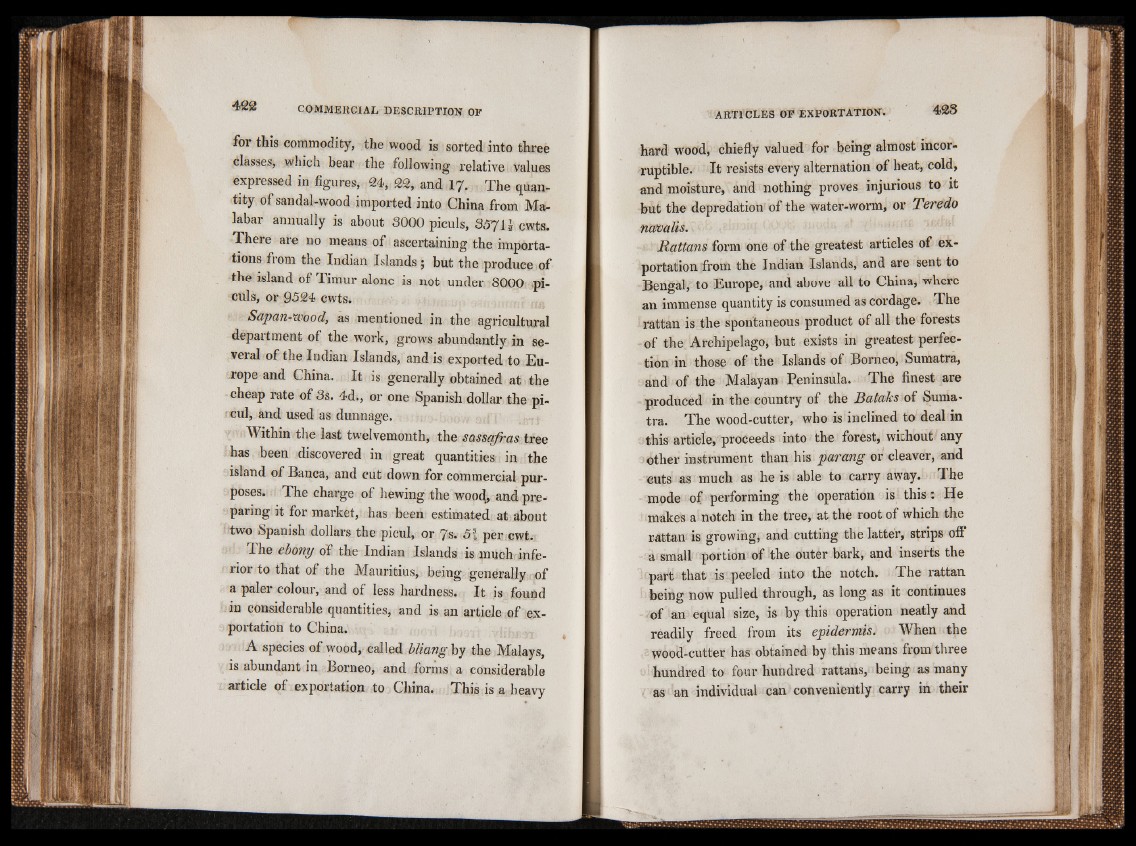
for this commodity, the wood is sorted into three
classes, which hour the following relative values
expressed in figures, 24, 22, and 1 7 . The quantity
of sandal-wood imported into China from Malabar
annually is about 3000 piculs, 35711 cwts.
There are no means of ascertaining the importations
from the Indian Islands ; but the produce of
the island of Timur alone is not under 8000 piculs,
or 9524 cwts.
Sapan-wood, as mentioned in the agricultural
department of the work, grows abundantly in several
of the Indian Islands, and is exported to Europe
and China. | It is generally obtained at the
cheap rate of 3s. 4d., or one Spanish dollar the picul,
and used as dunnage. © Within the last twelvemonth, the sassafras tree
has been discovered in great quantities in the
island of Banca, and cut down for commercial purposes.
The charge of hewing the wood, and preparing
it for market, has been estimated at about
two Spanish dollars the picul, or 7 s. 5 | per cwt.
The ebony of the Indian Islands is much inferior
to that of the Mauritius, being generally of
a paler colour, and of less hardness. It is found
in considerable quantities, and is an article of exportation
to China.
A species of wood, called bliang by the Malays,
is abundant in Borneo, and forms a considerable
article of exportation to China. This is a heavy
hard wood, chiefly valued for being almost incorruptible.
It resists every alternation of heat, cold,
and moisture, and nothing proves injurious to it
but the depredation of the water-worm, or Teredo
navalis.
Rattans form one of the greatest articles of exportation
from the Indian Islands, and are sent to
Bengal, to Europe, and above all to China, where
an immense quantity is consumed as cordage. The
rattan is the spontaneous product of all the forests
of the Archipelago, but exists in greatest perfection
in those of the Islands of Borneo, Sumatra,
and of the Malayan Peninsula. The finest are
producéd in the country of the Bataks of Sumatra.
The wood-cutter, who is inclined to deal in
this article, proceeds into the forest, wishout any
other instrument than his parang or cleaver, and
cuts as much as he is able to carry away. The
mode of performing the operation is this: He
makes a notch in the tree, at the root of which the
rattan is growing, and cutting the latter, strips off
a small portion of the outer bark, and inserts the
part that is peeled into the notch. The rattan
being now pulled through, as long as it continues
of an equal size, is by this operation neatly and
readily freed from its epidermis. When the
wood-cutter has obtained by this means from three
hundred to four hundred rattans, being as many
as an individual can conveniently carry in their